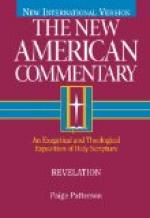When the covenant was made between God and Abraham,
upon which all the subsequent revelation reposed, the
divine presence was represented by a smoking furnace,
and a lamp of fire that passed between the divided
pieces of the sacrifice. When the great revelation
of the divine Name was given to Moses, which prepared
for the great deliverance from Egypt, the sign of
it was a thorn-bush—one of the many dotted
over the desert—burning and unconsumed.
Surely the ordinary interpretation, which sees, in
that undying flame, an emblem of Israel undestroyed
in the furnace of bondage, is less natural than that
which sees in it a sign having the same purpose and
the same meaning as the deep words, ‘I am that
I am.’ The Name, the revelation proper,
is accompanied by the sign which expresses in figure
the very same truth—the unwearied power,
the undecaying life of the great self-existent God,
who wills and does not change, who acts and does not
faint, who gives and is none the poorer, who fills
the universe and is Himself the same, who burns and
is not consumed—the ‘I am.’
Further, we remember how to Israel the pledge and
sacramental seal of God’s guardianship and guidance
was the pillar which, in the fervid light of the noonday
sun, seemed to be but a column of wavering smoke, but
which, when the darkness fell, glowed at the heart
and blazed across the sleeping camp, a fiery guard.
‘Who among us,’ says the prophet, ’shall
dwell with everlasting burnings?’ The answer
is a parallel to the description given in one of the
Psalms in reply to the question, ’Lord, who
shall abide in Thy tabernacle?’ From which parallelism,
as well as from the whole tone of the passage, the
conclusion is unavoidable that to Isaiah ‘everlasting
burnings’ was a symbolic designation of God.
And, passing by all other references, we remember
that our Lord Himself used the same emblem, as John
does, with apparently the same meaning, when, yearning
for the fulfilment of His work, He said,’ I am
come to send fire on earth—oh that it were
already kindled!’ The day of Pentecost teaches
the same lesson by its fiery tongues; and the Seer
in Patmos beheld, burning before the throne, the sevenfold
lamps of fire which are ‘the seven spirits of
God.’
Thus, then, there is a continuous chain of symbolism
according to which some aspect of the divine nature,
and especially of the Spirit of God, is set forth
for us by fire. The question, then, comes to be—what
is that aspect? In answer, I would remind you
that the attributes and offices of the Spirit of God
are never in Scripture represented as being destructive,
and are only punitive, in so far as the convictions
of sin, which He works in the heart, may be regarded
as being punishments. The fire of God’s
Spirit, at all events, is not a wrathful energy,
working pain and death, but a merciful omnipotence,
bringing light and joy and peace. The Spirit
which is fire is a Spirit which giveth life.
So the symbol, in the special reference in the text,
has nothing of terror or destruction but is full of
hope and bright with promise.




